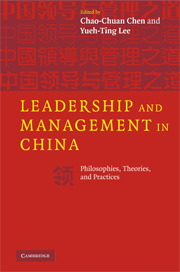Book contents
- Frontmatter
- Contents
- List of figures
- List of tables
- List of contributors
- Preface
- Acknowledgments
- Introduction: The diversity and dynamism of Chinese philosophies on leadership
- Part I The Confucian foundations
- Part II Alternative traditional Chinese leadership philosophies
- Part III Modern Chinese leadership theories and practices
- 6 Paternalistic leadership in Chinese organizations: research progress and future research directions
- 7 The leadership theories and practices of Mao Zedong and Deng Xiaoping
- 8 Chinese traditions and Western theories: influences on business leaders in China
- 9 Linking Chinese leadership theory and practice to the world: leadership secrets of the Middle Kingdom
- Index
- References
6 - Paternalistic leadership in Chinese organizations: research progress and future research directions
Published online by Cambridge University Press: 14 May 2010
- Frontmatter
- Contents
- List of figures
- List of tables
- List of contributors
- Preface
- Acknowledgments
- Introduction: The diversity and dynamism of Chinese philosophies on leadership
- Part I The Confucian foundations
- Part II Alternative traditional Chinese leadership philosophies
- Part III Modern Chinese leadership theories and practices
- 6 Paternalistic leadership in Chinese organizations: research progress and future research directions
- 7 The leadership theories and practices of Mao Zedong and Deng Xiaoping
- 8 Chinese traditions and Western theories: influences on business leaders in China
- 9 Linking Chinese leadership theory and practice to the world: leadership secrets of the Middle Kingdom
- Index
- References
Summary
Paternalistic leadership (PL) is an indigenous Chinese leadership style that is rooted in China's patriarchal tradition and has been found to be prevalent in overseas Chinese family businesses. Farh and Cheng (2000) proposed a model of PL that has three components: authoritarianism, benevolence, and moral leadership. Since then, a series of empirical studies have been conducted by Cheng and his colleagues to examine the validity of Farh and Cheng's PL model using a variety of samples from Taiwan and mainland China. In this chapter, we review this body of research and identify promising areas for future research.
Introduction
In the second half of the twentieth century, entrepreneurship among overseas Chinese exploded not only in Chinese-dominated communities such as Hong Kong, Singapore, and Taiwan, but also in South-east Asian countries, such as Indonesia, Malaysia, Thailand, and the Philippines, where the Chinese are in the minority (Weidenbaum, 1996). Scholars who were intrigued by this phenomenon embarked on a series of studies of the practices of overseas Chinese businesses. They discovered a distinct management/leadership style called paternalism, widely practiced among the owners/managers of overseas Chinese family businesses (e.g. Cheng, 1995c; Redding, 1990; Silin, 1976; Westwood, 1997). Paternalism, which is rooted in the traditional Chinese family structure, has crossed the boundary of families and generalized to the workplace.
- Type
- Chapter
- Information
- Leadership and Management in ChinaPhilosophies, Theories, and Practices, pp. 171 - 205Publisher: Cambridge University PressPrint publication year: 2008
References
- 109
- Cited by

